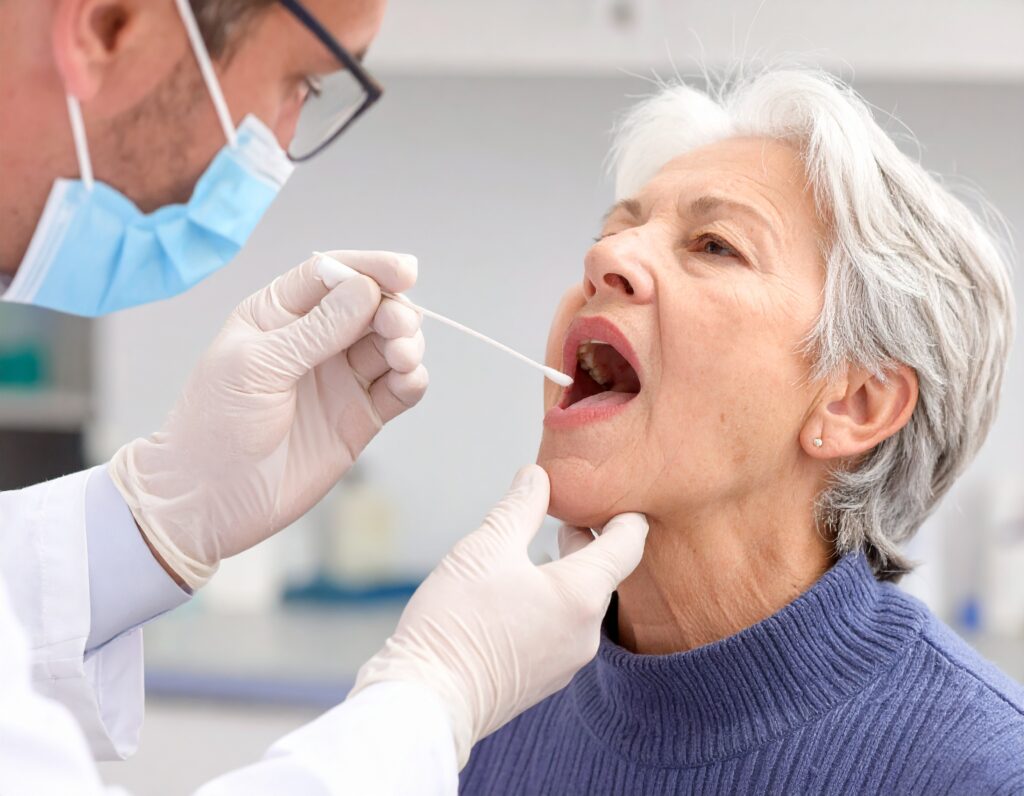
Saliva Testing for Alzheimer’s Disease: A Promising,Non-Invasive Path Towards Earlier Detection
Early Detection Matters
Early detection is critical in Alzheimer’s disease (AD) diagnosis: available treatments that slow decline work best when started early, and people and families benefit from planning and care decisions long before dementia is advanced. Traditionally, definitive biomarker testing for AD has required cerebrospinal fluid (CSF) draws from a spinal tap or PET scans—accurate but invasive, expensive, or hard to scale. That’s why researchers already working on somewhat invasive blood modalities are now exploring saliva as a much simpler, non-invasive fluid that may one day help screen and monitor Alzheimer’s disease.
Why Saliva?
Saliva is easy to collect (no needles, clinic visit, or lumbar puncture), low-cost, and acceptable for repeated sampling. It contains proteins, peptides, enzymes, hormones, metabolites, extracellular vesicles (exosomes), and molecules from oral and systemic tissues—many of which can reflect brain pathology or systemic responses linked to neurodegeneration. Recent advances allow stabilization of saliva specimens at the point of collection, enabling downstream testing to be performed on samples shipped to a laboratory without the patient leaving home.
While biomarkers in saliva are often present in lower quantities than in blood or CSF, certain critical biomarkers evaluated for AD (amyloid-β and tau proteins) are present in sufficient concentrations to be analyzed by existing technologies. Other analytes—such as lactoferrin, inflammatory proteins, metabolites, or genomic, transcriptomic, and microbial signatures—have also been widely reported.
What Biomarkers Are Researchers Finding in Saliva?
Studies have looked at genomics, proteomics, transcriptomics, metabolomics, and other “omics” approaches, identifying several candidate salivary markers associated with Alzheimer’s disease or mild cognitive impairment (MCI). A non-exhaustive list includes:
- Amyloid-ß (Aß40, Aß42)
- Tau and phosphorylated-tau (p-tau), including p-Tau-181 and p-Tau-217
- GFAP
- Neurofilament light chain (nFL)
A recent publication highlights prior work applying saliva to AD testing and provides guidelines aimed at standardizing studies worldwide to eliminate lab-to-lab variability.
In addition, the following biomarkers appear important:
- Lactoferrin — Lower levels in saliva from people with AD, correlating with CSF AD biomarkers in some cohorts, suggesting screening potential.
- Inflammatory proteins, metabolites, and exosomes — Multi-marker panels have shown high diagnostic accuracy in small studies for distinguishing MCI/AD from normal aging.
- APO-E genotyping — The Alzheimer’s Association has used saliva in the NEWIDEAS study, and the Worldwide FINGERS Project (including studies in Africa) also uses saliva for biomarker research.
Recent Advances and Tools
Over the past few years, consensus papers have moved the field forward by describing standardized collection protocols and methodologies to improve consistency. Automated platforms that traditionally evaluate blood or plasma are now being adapted for saliva. Point-of-care devices are also being developed to detect saliva biomarkers quickly and affordably. Early device prototypes, including handheld sensors, show feasibility though remain experimental.
Spotlight on Oasis Diagnostics
One leader in developing saliva-based diagnostic platforms is Oasis Diagnostics Corporation (Vancouver, WA). Building on decades of experience in the saliva market, Oasis is working to translate Alzheimer’s biomarker research into real-world testing tools.
Their technologies include:
- Super•SAL™, Pure•SAL™, SimplOFy™, RNAPro•SAL™ — Devices for saliva collection and stabilization, used in Alzheimer’s research by the Alzheimer’s Association, the Davos Alzheimer’s Collaborative, and the Worldwide FINGERS Project.
- Micro•SAL™, DNA•SAL™ — Designed for infants, children, small animals, and easy sampling of DNA/proteins.
- VerOFy® / LIAM™ Point-of-Care Platform — A fully quantitative lateral flow saliva test providing results in 20 minutes with a handheld reader.
Why it matters: Oasis bridges the gap between lab research and practical application, focusing on devices that make non-invasive Alzheimer’s screening possible outside of specialty clinics.
Strengths — Why Saliva Matters
- Non-invasive and repeatable: Ideal for longitudinal monitoring and for patients unwilling or unable to undergo lumbar puncture or PET scans.
- Low cost & scalable: Enables broader screening and population studies, including in low- and middle-income countries.
- Multi-marker potential: Combining proteins, metabolites, and exosomes may improve accuracy over single biomarkers.
Limitations and Challenges
- Variability & standardization: Saliva composition depends on collection method, timing, oral health, medications, etc. Standardized protocols are critical.
- Lower concentrations: Biomarkers appear in lower amounts than in CSF or blood, requiring sensitive assays and validation.
- Clinical validation: Most findings are from small cohorts; larger, diverse studies are needed.
What This Means for Patients and Clinicians
Saliva testing is promising but not yet a replacement for established diagnostics. Currently, biomarkers remain in the research and validation phase. In the next few years, expect:
- Better-standardized collection and testing protocols
- Larger clinical studies comparing saliva, blood, CSF, and PET
- Early applications as screening or monitoring tools that flag people for more definitive testing
Bottom Line
Saliva testing offers a compelling, patient-friendly avenue toward earlier and more accessible Alzheimer’s screening. Scientific momentum—driven by biomarker discovery, assay improvements, and device development—suggests saliva could become a useful component of AD detection and monitoring, especially as part of multi-marker panels or triage workflows.